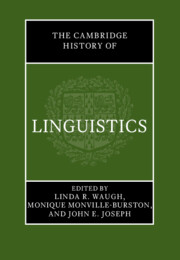Book contents
- The Cambridge History of Linguistics
- The Cambridge History of Linguistics
- Copyright page
- Dedication
- Contents
- Figures
- Tables
- Contributors
- Preface
- Acknowledgments
- Abbreviations, Acronyms, Special Symbols, and Other Conventions
- Introduction
- Part I Ancient, Classical, and Medieval Periods
- Part II Renaissance to Late Nineteenth Century
- Introduction to Part II The Cultural and Political Context of Language Studies from the Renaissance to the End of the Nineteenth Century
- 7 Universal Language Schemes
- 8 Locke and Reactions to Locke, 1700–1780
- 9 Rousseau to Kant
- 10 The Celebration of Linguistic Diversity: Humboldt’s Anthropological Linguistics
- 11 Early Nineteenth-Century Linguistics
- 12 The Neogrammarians and their Role in the Establishment of the Science of Linguistics
- Part III Late Nineteenth-through Twentieth-Century Linguistics
- Part IIIA Late Nineteenth Century through the 1950s: Synchrony, Autonomy, and Structuralism
- Part IIIB 1960–2000: Formalism, Cognitivism, Language Use and Function, Interdisciplinarity
- References
- Index
11 - Early Nineteenth-Century Linguistics
from Part II - Renaissance to Late Nineteenth Century
Published online by Cambridge University Press: 20 July 2023
- The Cambridge History of Linguistics
- The Cambridge History of Linguistics
- Copyright page
- Dedication
- Contents
- Figures
- Tables
- Contributors
- Preface
- Acknowledgments
- Abbreviations, Acronyms, Special Symbols, and Other Conventions
- Introduction
- Part I Ancient, Classical, and Medieval Periods
- Part II Renaissance to Late Nineteenth Century
- Introduction to Part II The Cultural and Political Context of Language Studies from the Renaissance to the End of the Nineteenth Century
- 7 Universal Language Schemes
- 8 Locke and Reactions to Locke, 1700–1780
- 9 Rousseau to Kant
- 10 The Celebration of Linguistic Diversity: Humboldt’s Anthropological Linguistics
- 11 Early Nineteenth-Century Linguistics
- 12 The Neogrammarians and their Role in the Establishment of the Science of Linguistics
- Part III Late Nineteenth-through Twentieth-Century Linguistics
- Part IIIA Late Nineteenth Century through the 1950s: Synchrony, Autonomy, and Structuralism
- Part IIIB 1960–2000: Formalism, Cognitivism, Language Use and Function, Interdisciplinarity
- References
- Index
Summary
Although many strands in eighteenth-century language study (philosophical grammar, cross-linguistic comparisons, philological work) persisted in the early nineteenth century, there were also new developments which had important effects for linguistics:1. Establishment of Indo-European linguistics. Jones’s remarks on the relationship between Indo-European languages followed by demonstrations of this relationship (Schlegel, Bopp), discovery of systematic correspondences between Indo-European languages and the formulation of sound ‘laws’ (Rask, Grimm). Schleicher’s family-tree model illustrated the evolution and relationships of Indo-European languages. It was finally recognized that Sanskrit is a daughter of Indo-Iranian, like the other ancient Indo-European languages, not their ancestor. 2. Towards phonetics as an independent discipline: Rask’s and Grimm’s relatively underdeveloped phonetics improved under the influence of the Sanskrit tradition, systems of sound classification were elaborated, with a move towards the creation of a universal phonetic alphabet. 3. Professionalization of linguistics (first in Germany) and trend towards ‘scientific’ linguistics through its progressive separation from philosophy and philology. The work of linguists (Schlegel) and philologists (Lassen) of the period had unfortunate ideological repercussions beyond linguistics and can be seen as having contributed to twentieth-century racism (cf. the Indian nationalist movement’s ‘Aryan invasion theory’ and the Nazis’ Aryan myth).
Keywords
- Type
- Chapter
- Information
- The Cambridge History of Linguistics , pp. 326 - 344Publisher: Cambridge University PressPrint publication year: 2023



